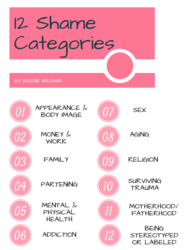Shame and the Antidote
Shame is the painful feeling of humiliation or distress caused by the consciousness of wrong or foolish behaviour. It’s extremely uncomfortable because when we experience shame, we feel flawed, like an outsider, are seen with unlikeable traits, or feel rejected. This feeling can be triggered by someone’s response to us, a situation, or by ourselves when we see a way in which we didn’t meet our own expectations. We feel bad about ourselves and want to coverup or hide.
Shame even hides behind other emotions such as anger and fear. We respond to shame by either trying to gain control by moving against it, withdrawing by moving away or seeking approval/belonging by moving towards it. In this way shame effects our survival instinct, our fight, flight, or freeze response.
How can we respond to shame?
- Recognize Shame – notice how your body reacts to shame, and use your senses to determine what shame looks, feels, smells, sounds, and tastes like.

When you feel shame, how do you feel physiologically? Maybe your body shuts-down, you want to run, or you get ready to fight. Notice how this feels, what it looks like as well as the other ways you respond.
- Identify Triggers – notice what external stimuli triggered shame.
Pay attention to past moments that you have felt shame and recall what someone said or did that triggered this response as well as what shame category this falls into. Maybe there are a few categories, know what these triggers are.
- Identify where you are vulnerable – unwanted identities
Once you have identified your triggers and the shame categories they fall into, think about what it is that you project to other people. It may be that you’re capable, a free spirit, fun-loving, or competitive. The reality is that the way you want people to see you is where you wear your mask. What type of identity do you project to others?
- Embrace your vulnerability – know your weaknesses/ soft spots
If we do not cover up in response to shame, and instead embrace vulnerability our needs can be displayed. Many of us see our needs as negative and create mass disconnection in our community. We perceive that people would leave the room if we admitted what we needed. We must dial into courage in order to be vulnerable, to not shrink away from shame but to lean in and admit what we feel and need. We regulate healthily in relationship when we speak shame, we break the isolation of shame and stop hiding because we admit our need for relationship. Accept and get to know the emotions you have; your emotions are an expression of you.
As much as shame causes us to want to hide, the antidote to shame, is not hiding, but rather, it is recognition, identification, and a movement towards vulnerability and empathy.
Brown, C. Brené. Daring Greatly: How the Courage to Be Vulnerable Transforms the Way We Live, Love, Parent, and Lead. New York, N.Y.: Gotham, 2012.
Hastie, Susan Z. Developing Shame Resiliency – Building Healthy Connections, 2019.
Brianna Matchett, MC, is trained in many areas such as anxiety and self-esteem, plus many more. For more information on Brianna and her work, click here to link to her full bio page.




